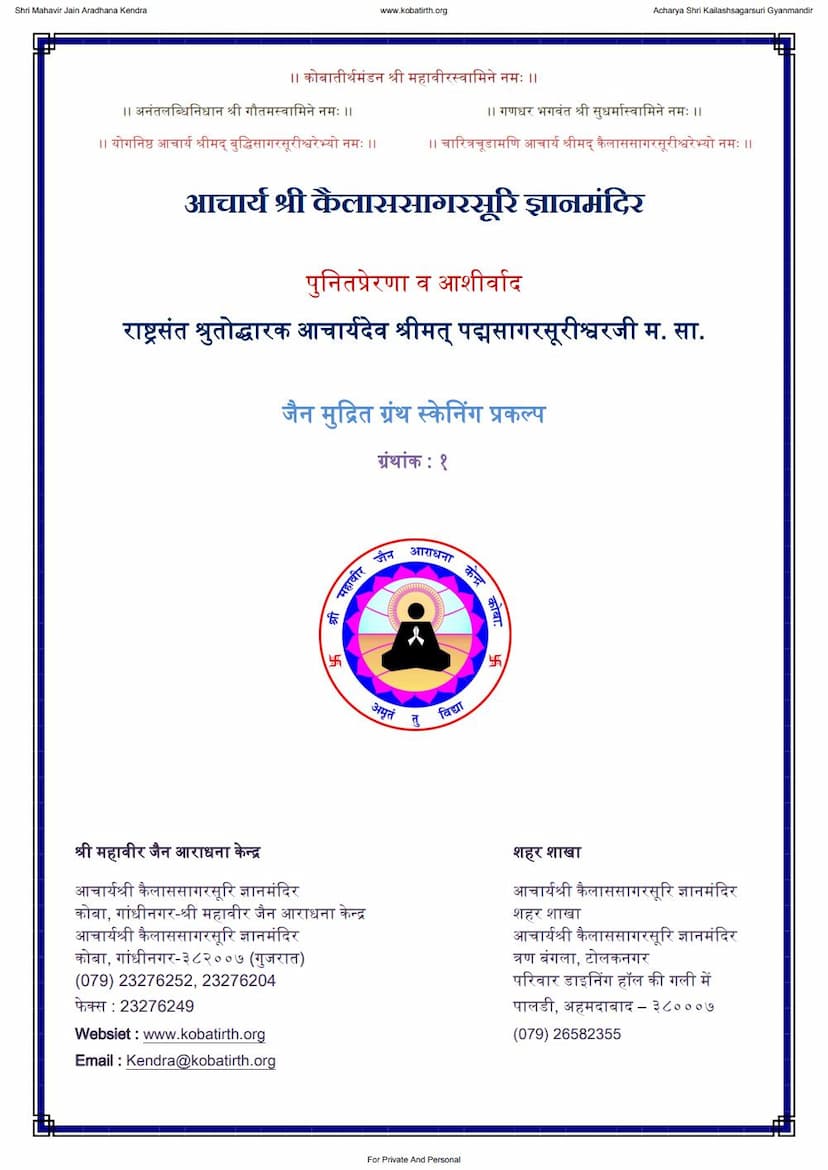Parashar Smruti Part 01
Added to library: September 2, 2025

Summary
Here's a comprehensive summary of the provided Jain text, "Parashar Smruti Part 01," based on the initial pages you've shared, focusing on the content and context presented:
Overall Context:
The text is identified as "Parashar Smruti Part 01," authored by Madhavacharya and edited by Chandrakant Tarkalankar, published by the Asiatic Society. The catalog link points to the JainQQ.org archive, indicating this is a significant Sanskrit text, potentially focusing on Dharmaśāstra (law and ethics). The preface mentions that this is Volume One, containing the "Āchāra-kāṇḍa" (Code of Conduct), with Volume Two containing "Prāyaśchitta Kanda" (Expiation) and "Vyavahāra Kanda" (Law). The Asiatic Society first published an edition in 1890-93, and this reprint is from 1974.
Key Themes and Content in the Provided Pages:
-
Invocation and Salutations (Page 1 & 11): The text begins with traditional Sanskrit invocations to Shri Mahavir, Shri Gautam Swami, Acharya Shrimad Buddhisagarsuri, Acharya Shrimad Kailashsagarsuri, and Shri Sudharmaswami. This establishes a connection to Jain traditions and venerated figures.
-
Bibliographical Information (Pages 4-6): This section provides detailed information about the work, including its title (Parāśara-Smṛti), the commentator (Mādhavāchārya), the editor (Mahāmahopādhyāya Chandrakānta Tarkālaṅkāra), and the publisher (The Asiatic Society). It highlights that this volume is the Āchāra-kāṇḍa of the Parāśara Smṛti with the gloss of Madhavāchārya.
-
Preface (Pages 7-8): The preface by S. K. Mitra, General Secretary of The Asiatic Society, explains the publication.
- It acknowledges the delay in publishing this volume compared to Volume Two.
- It thanks the Samkara Vidyābhavana Chatuṣpāṭhi and Sanskrit College, Calcutta, for lending copies.
- It introduces the core concept of the Parāśara Smṛti, emphasizing āchāraḥ prabhavo dharmaḥ (conduct is the origin of dharma), as observed by Parāśara.
- It explains that the Āchāra-kāṇḍa discusses the basic duties of all four varṇas (social classes), their domestic and socio-religious rites, ceremonies, and social relationships, always with an accommodating spirit towards the changing times.
- It highlights the value of Madhavāchārya's gloss, which not only explains the text but also provides a digest of social and religious regulations, offering critical analysis and inner significance. Madhava's methodology influenced later commentators.
-
Introduction to the Text and Commentary (Pages 11-18):
- The text itself begins with invocations (page 11).
- It immediately delves into a philosophical discussion about the pramāṇya (authority/validity) of Smṛtis (traditional texts). The author (likely Madhavacharya in his commentary) addresses the challenge of establishing the authority of a Smṛti, which is a pauruṣeya (human-authored) text, unlike the apauruṣeya (non-human-authored) Vedas.
- The argument is presented that Smṛtis derive their authority from the Vedas, but the original Vedic source (chodanā) is often unavailable or not directly inferable.
- The text discusses the potential unreliability of human statements (pauruseya) due to deception (vipralambha) or error (saṃśaya, viparyaya).
- It preemptively addresses the argument that Manu's Smṛti is validated by Vedic statements ("yadākiṃ ca manur avadat tan'neṣajam"), while Śākyādi (Buddhist and other heterodox) traditions lack such Vedic backing.
- The author argues that even Manu's validation as "medicine" is an arthavāda (a passage meant to praise or support a vidhi or rule) and does not establish independent authority.
- The section concludes with a defense of the Smṛtis' authority, arguing for their svataḥ pramāṇya (inherent validity) due to the absence of reasons for apramāṇya (invalidity) and the corroboration from Vedic injunctions (chodanā) that are inferable.
- The discussion touches upon the nature of chodanā (injunctions) and how they relate to practices like śaucha (purity) and āchāra (conduct).
-
Structure and Scope of Parāśara Smṛti (Pages 23-24):
- The text outlines the structure of the Parāśara Smṛti itself: two kāṇḍas (parts) with twelve adhyāyas (chapters) and 608 ślokas (verses).
- The first part is Āchāra-kāṇḍa, and the second is Prayaśchitta-kāṇḍa.
- The purpose of these parts is stated as achieving desired results (dṛṣṭa-prāpti) and avoiding undesired ones (aniṣṭa-nivṛtti). Āchāra-kāṇḍa focuses on the former, and Prayaśchitta-kāṇḍa on the latter.
In essence, the provided pages of "Parashar Smruti Part 01" introduce the text, its author and commentator, and begin a rigorous philosophical defense of the authority of Smṛtis within the broader framework of Vedic injunctions. It lays the groundwork for the detailed discussion of āchāra (conduct) by establishing the validity of the source text and its commentary.